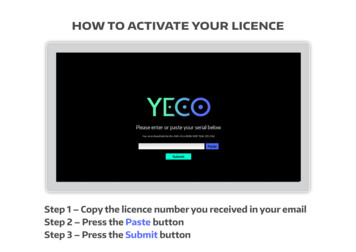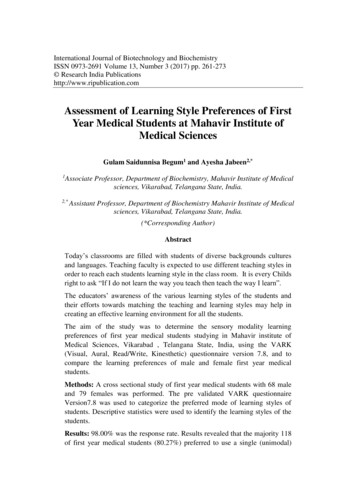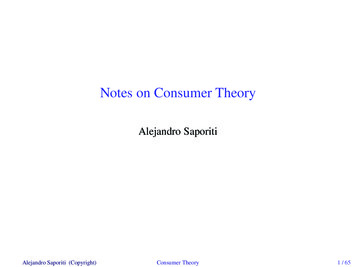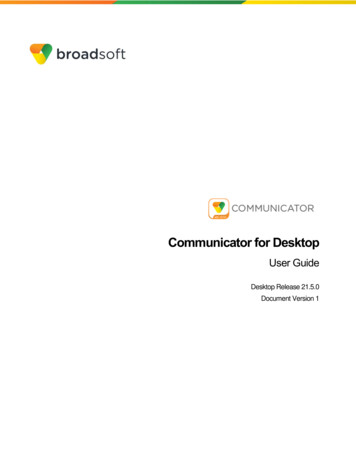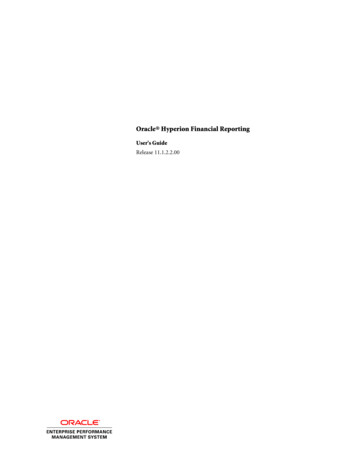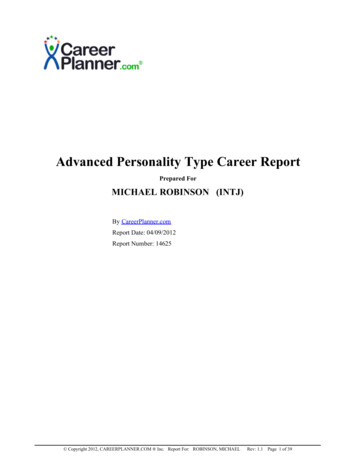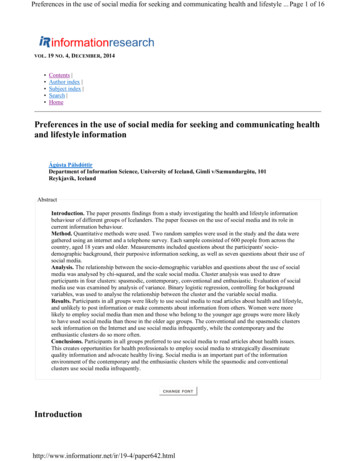
Transcription
Preferences in the use of social media for seeking and communicating health and lifestyle . Page 1 of 16VOL. 19 NO. 4, DECEMBER, 2014 Contents Author index Subject index Search HomePreferences in the use of social media for seeking and communicating healthand lifestyle informationÁgústa PálsdóttirDepartment of Information Science, University of Iceland, Gimli v/Sæmundargötu, 101Reykjavík, IcelandAbstractIntroduction. The paper presents findings from a study investigating the health and lifestyle informationbehaviour of different groups of Icelanders. The paper focuses on the use of social media and its role incurrent information behaviour.Method. Quantitative methods were used. Two random samples were used in the study and the data weregathered using an internet and a telephone survey. Each sample consisted of 600 people from across thecountry, aged 18 years and older. Measurements included questions about the participants' sociodemographic background, their purposive information seeking, as well as seven questions about their use ofsocial media.Analysis. The relationship between the socio-demographic variables and questions about the use of socialmedia was analysed by chi-squared, and the scale social media. Cluster analysis was used to drawparticipants in four clusters: spasmodic, contemporary, conventional and enthusiastic. Evaluation of socialmedia use was examined by analysis of variance. Binary logistic regression, controlling for backgroundvariables, was used to analyse the relationship between the cluster and the variable social media.Results. Participants in all groups were likely to use social media to read articles about health and lifestyle,and unlikely to post information or make comments about information from others. Women were morelikely to employ social media than men and those who belong to the younger age groups were more likelyto have used social media than those in the older age groups. The conventional and the spasmodic clustersseek information on the Internet and use social media infrequently, while the contemporary and theenthusiastic clusters do so more often.Conclusions. Participants in all groups preferred to use social media to read articles about health issues.This creates opportunities for health professionals to employ social media to strategically disseminatequality information and advocate healthy living. Social media is an important part of the informationenvironment of the contemporary and the enthusiastic clusters while the spasmodic and conventionalclusters use social media infrequently.CHANGE 4/paper642.html
Preferences in the use of social media for seeking and communicating health and lifestyle . Page 2 of 16The paper presents findings from a study investigating the health and lifestyle information behaviour of different groupsof Icelanders. The paper focuses on the use of social media and its role in information behaviour today.The means of seeking, sharing and disseminating information has undergone huge changes in recent years. In particular,social media (e.g. Facebook, Twitter, Wikipedia, YouTube, blog, etc.) has in the past few years radically transformed theway that people can communicate. Information behaviour has been described as an encompassing and multifacetedconcept comprising all human interaction with information, namely acknowledgement of a need for information, seekingand evaluating information, as well as the use of it (Wilson, 2000). Social connections are particularly important in thisrespect because they can create and stimulate the flow of information. Social media offers promising possibilities at bothdisseminating and gathering information and the information derived from it is becoming increasingly important inpeople's everyday lives. For example, while many social networks preserve and support communication within preexisting social relations, other sites are primarily based on shared interests, where either a broad and diverse group ofstrangers or a more narrow and intimate group of people can connect and discuss with one another (Boyd and Ellison,2007).Knowledge of how interest in healthy behaviour can be provoked, how the decision to take up a more healthy behaviourcan be enhanced, and how the maintenance of a healthy behaviour change can be supported, is an important aspect ofhealth promotion and has a strong connection to information behaviour (Prochaska and Velicer, 1997). Social media hasthe potential to support and influence information behaviour in several ways. For example, health specialists can presentquality information about healthy living and potentially inspire people to discover such information. Additionally, friendsor acquaintances can provide support and inspiration through discussions. The main change from traditional internetsources has been from monologue, where information is disseminated through webpages, newspapers or journals on theWeb, to dialogue, where several people can communicate, ask questions, exchange information and get feedback fromone another. Although this may create challenges, with the possibility of the spread of inaccurate and misleadinginformation, it also provides health professionals with new opportunities to disseminate information about healthy living,as well as for people to gather such information and receive health support.The Pew Internet Project has conducted a series of studies to examine trends in the use of Internet sources in Americasince 2000. Their findings show that even though social media is being used by 46% of all American adults and 62% ofadult internet users (Fox, 2011), the use of social media among American older adults has been growing significantly inthe past few years (Zickuhr and Madden, 2012). However, the use of social media for communicating about healthinformation is only moderate (Fox, 2011). This is in line with previous findings about online information seeking whichindicates that most people seem to seek online health information infrequently (Lorence, Park and Fox, 2006).Kontos et al. (2010) have examined the demographic profile of adult users of social networking sites for healthinformation and found that the use decreased as age increased and that those with lower education and income levels weremore frequent users of social networking sites than those with more education and higher income levels. The use of socialnetworking sites among Icelanders has been examined by Statistics Iceland (2012), which reported that 69% of Icelandersused social networking sites in 2012. Women and younger people were found to be the most active users of socialnetworking sites.Social networking sites have proved to be influential in improving access to health related information (Freyne et al.,2010, Zhang, He and Sang, 2013). It seems that people may have impact on the health behaviour of others by offeringthem opinions and advice (Scanfeld, Scanfield and Larson, 2010), as well as using social media to provide emotionalsupport (Moen, Smordal and Sem, 2009, Oha et al., 2013, Savolainen, 2010). It has, however, also been noted that thereliability and usefulness of the information may be questionable (Moorhead, Hazlett, Harrison, et al., 2013; Sajadi andGoldman, 2011) and health professionals have been encouraged to employ social media for the interaction and sharing ofquality information about health topics to the public (Robillard et al., 2013).Health lifestyles have been defined as "collective patterns of health-related behaviour based on choices from optionsavailable to people according to their life chances" (Cockerham, 2005: 55). In Iceland it is common to use the phrasehealth and lifestyle in relation to health promotion, e.g. in the media and by health specialists. Health and lifestyle refersto the lifestyle choices that people make and the impact it can have on their health. Information about physical exercise,healthy diets and how these can affect people's health has frequently been in the public debate in Iceland in recent years.The present study investigates preferences for employing social media to communicate and seek information about healthand lifestyle and compares it to their information seeking activity in other channels. Knowledge of the various factorsrelated to information behaviour and the use of social media is limited. Research in this area, particularly in relation tohealth information, is scarce internationally and practically non-existent in Iceland. It is therefore interesting to er642.html
Preferences in the use of social media for seeking and communicating health and lifestyle . Page 3 of 16the use of social media in relation to health and lifestyle information behaviour and seek answers to the followingresearch question:1. how do different groups of Icelanders prefer to use social media to seek and communicate information about healthand lifestyle?2. What is their use of social media in relation to health and lifestyle information compared with other informationchannels?MethodsPrevious studies exploring the use of social media for communicating and seeking information have employed bothqualitative and quantitative methods with good results. They have, for example, identified various ways in which socialmedia is used to acquire information. The purpose of this study is to compare different groups within society, examiningtheir use of social media and the preferred ways of using it, as well as to compare the use of social media with otherinformation channels. As the study aims to generalize the results to the wider population of Icelanders, it was decided touse quantitative methods in the study.Data collectionData were gathered from two samples using an internet and a telephone survey. For the telephone survey, a samplerepresenting the adult population in Iceland was used, consisting of 600 people from the whole country, aged 18 years andolder and randomly selected from the National Register of Persons in Iceland. Participants were contacted by telephoneand invited to answer the survey directly by telephone or by email.For the internet survey, a random sample of 600 people from the Social Science Research Institute at the University ofIceland net panel was used. The net panel consists of people aged 18 years or older from the whole country. A randomsample from the National Register of Persons in Iceland was contacted by telephone and people were asked if they werewilling to participate in the net panel. The choice of participants in the net panel follows strict methodological rules toavoid convenience sampling. The net panel is updated regularly to ensure that it corresponds with the distribution in thepopulation, regarding sex, age and residence.The data were gathered in spring 2012. Respondents consisted of 299 individuals belonging to the simple random sampledrawn from the National Register who were reached by telephone and 399 participants in the net panel. Women wereoverrepresented in the telephone survey, with 57.2% of the respondents being women. However, of those whoparticipated in the net panel survey, 50.9% were women and 49.1% were men. The age distribution of respondents fromboth samples was also different although not statistically significant. The respondents who answered the telephone survey(or provided their email addresses over the telephone) were slightly younger than the net panel respondents. While 20.4%of those answering the telephone survey were 18 to 29 years of age, the same held for 16.3% of those who belonged to thenet panel. It can therefore be said that each data collection method has advantages and disadvantages. The net panelreaches both men and women but those who belong to the youngest age groups (18-29 and 30-39) were reluctant toanswer surveys sent out to the net panel. By combining the datasets from these two surveys, the sex and age distributionwas closer to the corresponding distribution in the population. Both datasets were therefore merged, allowing answersfrom all individuals belonging to each set of data.The total response rate was 58.4%. Table 1 presents a comparison of the characteristics of the respondents in thecombined dataset, as well as in each dataset, with population parameters derived from Statistics Iceland.Table 1: Characteristics of the participants compared with the population in 2012CATI/CAWI sample Net Panel sample Combined sample Population% raw number) %(raw number) %(raw number) %(raw number)SexMen42.8 (128)49.1 (196)46.4 (324)49.9 (119.519)Women57.2 (171)50.9 (203)53.6 (374)50.1 (120.205)Total100% (299)100% (399)100% (698)100% (239.724)Age18-2920.4 (61)16.3 (65)18.1 (126)24.2 42.html
Preferences in the use of social media for seeking and communicating health and lifestyle . Page 4 of 1630-3940-4950-5960 TotalEducationPrimarySecondaryUniversityTotal19.4 (58)16.7 (50)16.4 (49)27.1 (81)100% (299)16.5 (66)19.5 (78)19.8 (79)27.8 (111)100% (399)17.8 (124)18.3 (128)18.3 (128)27.5 (192)100% (698)19.8 (44.364)20.3 (42.263)17.0 (40.424)18.7 (56.562)100% (239.724)23.5 (70)43.0 (129)33.5 (100)100% (299)16.5 (66)43.0 (172)40.5 (161)100% (399)19.5 (136)42.9 (301)37.6 (261)100% (698)28.7 (68,801)40.1 (96.129)31.2 (74,794)100% (239.724)For the combined dataset, the distribution of men and women reflects the population. The distribution of age, for thecombined dataset, falls within the 95% confidence limits for three out of five age groups, however there are more peoplein the oldest age group and less people in the youngest age group compared to the population. Educational level wasmeasured as the highest level of education completed. Three levels were distinguished: primary education includes thosewho have finished compulsory education (ten years of education); secondary education includes those who havecompleted vocational training, or secondary school; and university education. The proportion of people with secondaryeducation in the combined dataset is representative of the population. However, as a proportion of the population, morepeople with university education and fewer with primary education responded to the questionnaire.Measurements(1) Socio-demographic information included the variables: sex, age, marital status, residence, education and income.(2) Purposive information seeking. A list of 25 information sources was presented and respondents were asked: 'Have yousought information about health and lifestyle in any of the following sources'? A five-point response scale was used (Veryoften - Never). The information sources were grouped into four information channels named media, health specialists,Internet and interpersonal sources and total mean scores computed for each channel. The information channels weretested for internal reliability and in all cases, Cronbach's alpha proved satisfactory. For media it was 0.95; for healthspecialists it was 0.90; for Internet it was 0.94; and for interpersonal sources it was 0.85.(3) Social media use. The participants were asked if they had used social media (e.g. Facebook, Wikipedia, Twitter,YouTube, blog, etc.) and asked seven questions about the various ways in which they had used social media in relation tohealth and lifestyle information. This included questions about whether the participants had provided information abouthealth and lifestyle to social media, whether they had received information from others, commented, forwarded or "liked"information in social media. A five-point response scale was used (Very often - Never).In addition to measuring the use of social media, it was decided to use the Principal Component Factoring method ofextraction to examine the factor structure of the questions asked. The criteria for factor loadings were set above 0.3 andoblique rotation (Oblimin) was adopted in the analyses. For the analyses, multiple criteria, based on eigenvalue 1.00 anda scree test suggested that extracting one factor would be adequate. The factor which was named Social media explained74.39% of the total variance in the data. The scale was checked for internal reliability and Cronbach's alpha was 0.93.Analysis of the dataOwing to different response rates in two of the age groups and educational groups, the data were weighted to ensure thateach group had the correct proportionate weight in the overall results for the sample in comparison to the population as awhole. All results are shown weighted.The relationship between background variables and each question about the use of social media was analysed using chisquared.As the objective is to provide a picture which is different from traditional analysis of the data with socio-demographicvariables, a k-means cluster analysis was used to determine how the participants formed distinct groups based on theirpurposive information seeking (Everitt, Landau and Leese, 2001). Only those who gave answers with 20 sources or morewere included (N 674). Building on analysis of data from previous research, a four-cluster solution was drawn(Aldenderfer and Blashfield, 1984; Everitt et al., 2001; Pálsdóttir, 2005; Pálsdóttir, .html
Preferences in the use of social media for seeking and communicating health and lifestyle . Page 5 of 16The relationship between each of the seven questions about the use of social media and the information-seeking clusterswas analysed by analysis of variance. A post-hoc test (Tukey) was conducted to examine which of the four clusters differsignificantly.The variable social media was skewed. It was transformed into a dichotomous variable: participants who had used socialmedia, and participants who had never used social media, in relation to health and lifestyle information. Binary logisticregression, controlling for background variables, was used to analyse the use of the cluster of social media. Thespasmodic cluster was used as a comparable group against which the other clusters were measured. In the analysis,participants who had used social media were given the value 1, and those who had never used social media were given thevalue 0. Consequently, the results indicate that for values over 1 on Exp (B), the odds of using social media increase asthe value of the independent variable gets higher. Values under 0 indicate that the odds of using social media decrease asthe value of the independent variable gets lower.ResultsThe participants were asked a number of questions about the use of social media in relation to information about healthand lifestyle. This chapter will start by introducing results about how the background variables, sex, age and education,relate to each question. This will be followed by presenting the results from the cluster analysis and after that the resultsabout the information-seeking cluster's use of social media will be introduced. The results from the analyses of thevariable social media and how it relates to the background variables is then presented and finally the results from theanalysis of social media and the information-seeking clusters.Use of social media and relationship with background variables: sex, age and educationThe relationship between each question about the use of social media and the background variables was analysed by usingchi-squared. Only results about significant differences will be presented in Figures 1 to 7.The participants were asked if they had posted information about health and lifestyle in social media, for example bysharing a link, referring to an article or by posting their own text. The results are presented in Figure 1.Figure 1: Posted information about health and lifestyle - difference by sex, age and educationFigure 1 shows that women were more likely to have posted information about health and lifestyle than men (p .01). Theresults also show a difference by age, with those in younger age groups being more likely to have posted information thanthose in the older age groups (p .001). Additionally, participants with more education were more likely to have postedinformation than those with less education (p .05).Figure 2 presents results about participant's responses to health and lifestyle information which others had posted intosocial .html
Preferences in the use of social media for seeking and communicating health and lifestyle . Page 6 of 16Figure 2: Comments on health and lifestyle information posted by others in social media - difference by sex,age and educationAs is clear from Figure 2, there was a significant difference by sex, age and education. Women were more likely than mento have commented on information that others had posted (p .001) and younger participants were more likely to havemade comments than those who were older (p .001). Participants with more education were also more likely to havecommented on information than those who had less education (p .05).Results about how often participants had received information about health and lifestyle through social media, arepresented in Figure 3.Figure 3: Received information about health and lifestyle from others through social media - difference bysex and ageFigure 3 shows significant differences by sex and education. Women were more likely to have received information abouthealth and lifestyle from others than men (p .001) and those who are younger were more likely to have receivedinformation than those who are older (p .001).Participants were asked if they had forwarded or "liked" information about health and lifestyle that others had posted onsocial media. The results are shown in Figure l
Preferences in the use of social media for seeking and communicating health and lifestyle . Page 7 of 16Figure 4: Forwarded or "liked" information about health and lifestyle posted by others in social media difference by sex, age and educationFigure 4 shows that women were more likely to have forwarded or "liked" information that others had posted in socialmedia than men (p .001) and that those who are younger were more likely to have done so than those who are older(p .001). In addition, those who are more educated were more likely to have forwarded or "liked" information than thosewho have less education (p .05).Figure 5 presents results about if the participants had read an article about health and lifestyle by opening a link in socialmedia.Figure 5: Read articles about health and lifestyle through social media - difference by sex, age and educationAs can be seen in Figure 5, there was as significant difference by participants' sex, age and education. Women were morelikely to have read an article about health and lifestyle in social media than men (p .001). Results about age show thatyounger people were more likely to have done so than those who are older (p .001). More educated participants weremore likely to have read an article in social media (p .05).The participants were also asked if they had opened a link and read an advertisement about health and lifestyle in socialmedia, see Figure l
Preferences in the use of social media for seeking and communicating health and lifestyle . Page 8 of 16Figure 6: Read advertisements about health and lifestyle through social media - difference by sex, age andmarital statusFigure 6 shows that women were more likely to have read advertisements about health and lifestyle on social media thanmen (p .001) and that younger people were more likely to have done so than those who were older (p .001).Finally, results about how often the participants had signed up as friends or "liked" Facebook sites about health andlifestyle are presented in Figure 7.Figure 7: Signed up as friends or "liked" Facebook sites about health and lifestyle - difference by sex and ageFigure 7 shows that a significant difference was found for sex (p .001), with women being more likely than men to havesigned as friends or "liked" a health and lifestyle Facebook site. For age (p .001), younger participants were more likelyto have signed as friends or "liked" information on Facebook than older participants.Background variables and different ways of using social media: Most likely and least likelyactionsCombining the answers "very/rather often" and "rather seldom/very seldom", the results in Figures 1-7 show that men andwomen share an interest in seeking knowledge about health and lifestyle on social media by reading articles (men: tml
Preferences in the use of social media for seeking and communicating health and lifestyle . Page 9 of 16women: 76%). Men were, on the other hand, least likely to comment on information that others had posted (28%), whilewomen were least likely to post information to social media (39%).The results for the variables age and education are identical to the results about sex. For all the age groups, readingarticles (18-29: 91%, 30-39: 80%, 40-49: 75%, 50-59: 57%, 60 : 43%) was the most likely action, followed byadvertisements (18-29: 90%, 30-39: 67%, 40-49: 66%, 50-59: 50%, 60 : 37%). Posting information about health andlifestyle to social media was the least likely action (18-29: 49%, 30-39: 55%, 40-49: 45%, 50-59: 32%, 60 : 17%).Results for the variable, education show that reading articles was also the most likely action (primary: 59%, secondary:62%, university: 70%) followed by posting information (primary: 34%, secondary: 32%, university: 42%). Commentingon information posted by others (primary: 32%, secondary: 35%, university: 45%) was the least likely action.Information-seeking clustersFour clusters were drawn based on the participant's purposive information seeking. Information seeking activity of thecluster's was assessed by computing total mean scores for each of the information channels: media, health specialists,Internet and interpersonal sources. Post hoc tests (Tukey's tests) were carried out to examine statistical differences acrossthe clusters. Figure 8 presents an overview of the total mean scores (1 is never and 5 very often).Figure 8: Purposive information seeking activity across the information-seeking clustersThe clusters were named with reference to their information seeking activity and to their choice of information channels:spasmodic cluster (N 219; 218), conventional cluster (N 156; 176), contemporary cluster (N 59; 63) and theenthusiastic cluster (N 211; 217). The numbers for each cluster are first shown as weighted; and after that, as the actualnumber of respondents.Figure 8 shows that all the clusters prefer to seek information from interpersonal sources, by talking to members of theirfamily, close friends or acquaintances.The spasmodic cluster seeks information least often. The information seeking activity of this cluster, which is generallylow, is similar for media, health specialists and Internet but higher for Interpersonal sources.Information seeking in all channels was high in the enthusiastic cluster. The total mean scores for the informationchannels, besides interpersonal sources, suggest that members of this cluster are the most enthusiastic seekers ofinformation with a preference for a broad spectrum of information sources.The difference in information seeking activity across the contemporary and the conventional clusters is small; the maindifference between these two clusters lies in their preferences for information channels. Members of the per642.html
Preferences in the use of social media for seeking and communicating health and lifesty. Page 10 of 16cluster seek information more often from the internet and interpersonal sources while members of the conventional clusterseeks information more often in media and from health specialists (Tukey, p 0.05).Information-seeking clusters and use of social mediaAnalysis of variance was used to examine the relationship between each of the seven questions about the use of socialmedia and the information-seeking clusters. The results are presented in mean figures in Figure 9.Figure 9: Use of social media by the information-seeking clustersFigure 9 shows a significant difference across the clusters for all questions regarding the use of social media. For the firstand the last questions (marked as 1 and 7), the same kind of difference was found across the clusters. Members of thecontemporary and the enthusiastic clusters, which did not differ significantly, had posted information in social media(p .001), and signed up as friends or "liked" Facebook sites about health and lifestyle (p .001), significantly more oftenthan members of the spasmodic and conventional clusters.For the second question (2) it was found that members of the contemporary cluster had commented on information abouthealth and lifestyle from others most often, while members of the spasmodic and conventional clusters, which did notdiffer significantly, had done so least often. (p .001).For the other four questions (marked as 3, 4, 5 and 6) the same pattern of difference was found across the clusters in allcases (p .001). Members of the spasmodic cluster had received information about health and lifestyle (3) (p .001),forwarded or "liked" information posted by others (4) (p .001), and read both articles (5) (p .001) and advertisements (6)(p .001) about health and lifestyle through social media, the least often. Members of the conventional cluster hadparticipated in these activities less often than members of the enthusiastic and contemporary clusters, which did not differsignificantly.All four clusters preferred to use social media to open links to read articles about health and lifestyle and to readadvertisements. After that members of the spasmodic and conventional clusters preferred to receive information
health and lifestyle in relation to health promotion, e.g. in the media and by health specialists. Health and lifestyle refers to the lifestyle choices that people make and the impact it can h



